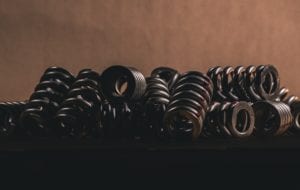Do you know the right material for your custom spring?
Technically, it’s possible to make a spring out of nearly any manufacturable material. But just because a material can be used for a spring doesn’t mean that it should be.
Not all materials can withstand the repetition and pressure that springs are subject to in the field. That’s why it’s important to find the right material for the type of precision spring your project needs.
If you’re not sure which material to choose or want to learn about the various options, we’re happy to explain it to you:
Common Materials for Custom Springs
Here’s a look at some of the most common materials used for custom springs:
Music wire

Made out of basic carbon spring steel, music wire is by far the most commonly used spring material. It’s a cost-effective option that boasts strong performance for the price. Music wire holds up well under somewhat high temperature conditions, functioning well at temperatures of up to 200 degrees Fahrenheit.
It’s important to note, however, that carbon steel is not corrosion resistant. Therefore, we don’t typically recommend music wire for outdoor applications or wet environments without a finish or coating to provide additional protection.
Stainless steel
When you need better corrosion resistance and functionality while your spring is exposed to high heat, stainless steel is usually the go-to option. Stainless steels are more expensive than basic steels, however using them often removes the need for secondary finish processes. There are a few grades of stainless steel for custom springs to choose from, including:
- 302 stainless steel. This standard stainless steel option is the most common; it has higher heat resistance and slightly less strength than music wire.
- 316 stainless steel. If you need a food-grade or cleanroom quality material with additional corrosion-resistant properties, 316 stainless steel is an excellent choice. This grade of stainless steel also offers a slightly higher heat resistance than 302 stainless steel.
- 17-7 stainless steel. The ultimate heat-resistant stainless spring material, 17-7 stainless steel can withstand temperatures of up to 600 degrees Fahrenheit and handle much greater stress than its other stainless steel counterparts.
Inconel X
Inconel X is used far less frequently than music wire or stainless steel—in part because it’s much more expensive. However, Inconel X can be a good choice for a small number of applications. This exotic material can withstand extremely high temperatures up to 1,100 degrees Fahrenheit.
Other materials
Other material options like brass, beryllium copper, and phosphor bronze are even less common, which make them more expensive and harder to source. These specialty materials are selected for specific properties such as: magnetic properties, corrosion resistance, electrical conductivity, resistance to acidic environments, or resistance to salt water environments.
While metal is considered the standard material for custom springs, 3D printers have recently begun producing plastic springs as well.
How to Choose a Precision Spring Material
Now that you know the most common spring materials, consider these factors when choosing the right one for your custom spring:
- Operating environment. Springs have different needs depending on the environment they’re operating in. Will the spring be in an outdoor application with high humidity? If so, you’ll need a corrosion-resistant material like stainless steel or plated music wire. Will the spring be subject to extreme temperatures? High heat environments may require special materials or heat treating.
- Number of spring cycles. Springs are designed to withstand many cycles of use without losing strength or failing. If your spring will need to endure millions of cycles during its lifetime, consider a high-tensile material with a long fatigue life that’s capable of handling repetition.
- Strength and flexibility. How much room does your spring have to compress or extend? Choose your material with dimensional constraints in mind. Using a high-tensile strength material will get you more strength out of the space the spring is in.
- Cost. Material costs are always a determining factor—especially at production volumes. But keep in mind that there’s a tradeoff between price and quality of material: any higher quality material is typically going to cost more and be more difficult to source, but it may be worth the price. A material like 316 stainless steel, for example, can help prevent corrosion, minimize stress, and even fight bacteria.
No matter your spring needs, Gifford Spring can help find a suitable material for you. It all starts with a conversation. Whether you need a spring designed from scratch or reverse engineered, hearing about your spring’s application helps us recommend the best material for you.
Request a quote for your custom spring today!